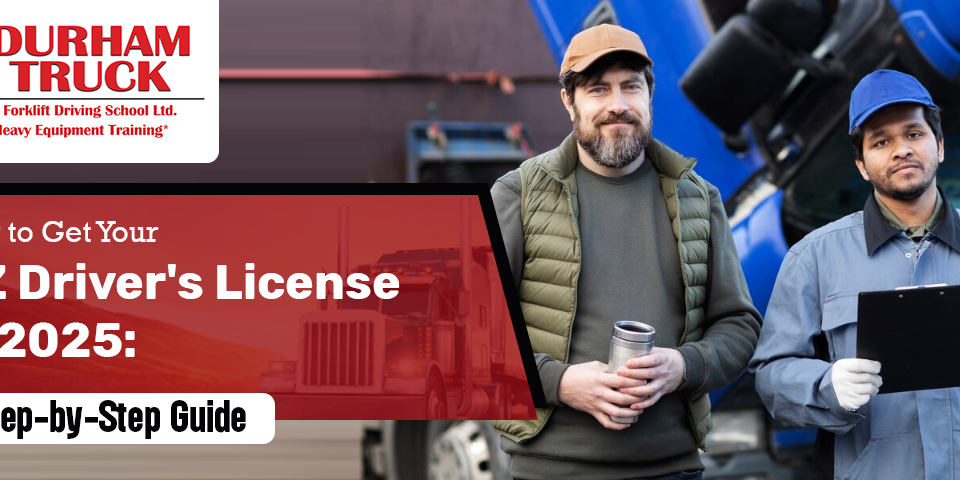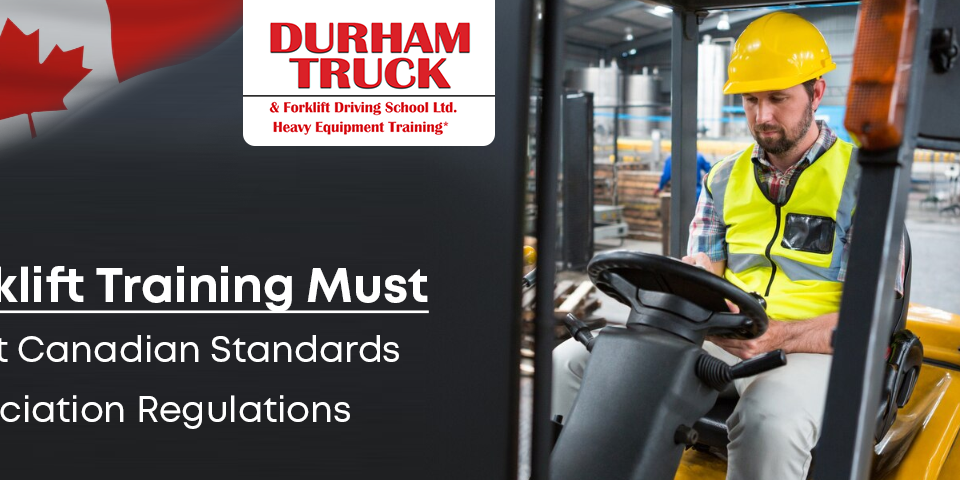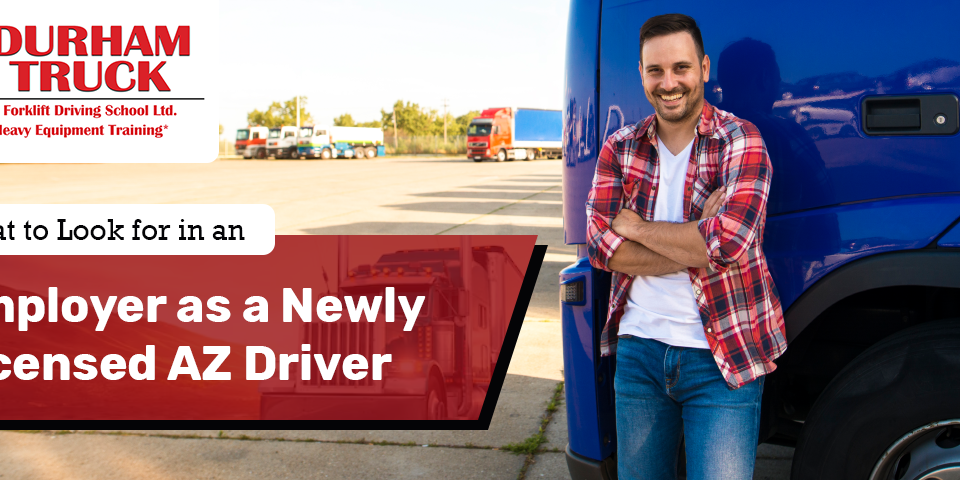Top 10 Safety Tips for Operating a Counterbalance Forklift

Common Forklift Accidents and How to Prevent Them
June 29, 2024
Essential Skills Every Aspiring Truck Driver Needs to Master
July 30, 2024Forklifts are indispensable in many industries, particularly in warehousing and logistics. Among various types, the counterbalance forklift is one of the most commonly used due to its versatility and ease of use. However, operating a counterbalance forklift comes with significant responsibility. Safety must always be a priority to prevent accidents and ensure a smooth workflow. At Durham Truck and Forklift Driving School Ltd., we emphasize the importance of proper training and adherence to safety protocols. Here are the top 10 safety tips for operating a counterbalance forklift.
- Comprehensive Training and Certification
Before operating a counterbalance forklift, it’s crucial to undergo comprehensive training and obtain proper certification. Training programs, like those offered at Durham Truck and Forklift Driving School Ltd., cover essential aspects such as the forklift’s mechanics, safety protocols, and hands-on practice. Certification ensures that the operator has the knowledge and skills to handle the equipment safely.
Key Points:
- Enroll in a recognized forklift training program.
- Complete both theoretical and practical components.
- Obtain certification from an accredited institution.
Why It Matters: Proper training and certification are foundational for safe forklift operation. They ensure operators understand how to handle the equipment, recognize potential hazards, and respond appropriately to emergencies.
- Conduct Pre-Operation Inspections
Before using a forklift, always perform a thorough pre-operation inspection. This helps identify potential issues that could lead to accidents or equipment failure. Key components to check include brakes, steering, controls, tires, mast, and forks. Ensure all safety features are functional, and report any malfunctions immediately.
Key Points:
- Inspect brakes, steering, and controls.
- Check tire condition and inflation.
- Ensure the mast and forks are in good condition.
- Test all safety features, including lights and horns.
Why It Matters: Regular inspections help catch problems early, preventing breakdowns and accidents. They ensure the forklift is in optimal working condition, contributing to a safer working environment.
- Wear Appropriate Personal Protective Equipment (PPE)
Wearing the correct PPE is crucial when operating a forklift. This includes safety shoes, a high-visibility vest, gloves, and a hard hat. PPE helps protect against injuries in accidents and makes the operator more visible to other workers.
Key Points:
- Wear safety shoes to protect your feet from falling objects.
- Use a high-visibility vest to increase visibility.
- Wear gloves to improve grip and protect hands.
- Use a hard hat to protect your head from overhead hazards.
Why It Matters: PPE is the last line of defense against injuries. It enhances the operator’s safety and ensures compliance with workplace safety regulations.
- Maintain Clear Communication
Effective communication is vital in environments where forklifts operate. Use standard hand signals and verbal communication to coordinate with other workers. Ensure that everyone in the vicinity knows the forklift’s movements to prevent accidents.
Key Points:
- Use standard hand signals for clear communication.
- Employ verbal communication when necessary.
- Ensure other workers are aware of the forklift’s movements.
- Use the horn to alert others when approaching blind corners.
Why It Matters: Clear communication helps prevent collisions and accidents, ensuring a safer workplace. It ensures that everyone is aware of the forklift’s movements and can respond accordingly.
- Adhere to Load Capacity Guidelines
Overloading a forklift can lead to tipping accidents and damage to the forklift and load. Always adhere to the manufacturer’s load capacity guidelines. Ensure the load is balanced and secure before moving.
Key Points:
- Follow the manufacturer’s load capacity guidelines.
- Ensure the load is balanced and secure.
- Use proper lifting techniques to avoid overloading.
Why It Matters: Adhering to load capacity guidelines prevents tipping accidents, ensures the forklift’s stability, protects the load from damage, and ensures safe transportation.
- Operate at Safe Speeds
Speeding is a common cause of forklift accidents. Continuously operate the forklift at safe speeds, especially in areas with pedestrian traffic or tight spaces. Slow down when turning, on ramps, and when approaching intersections or blind spots.
Key Points:
- Operate at safe speeds, especially in busy areas.
- Slow down when turning or on ramps.
- Use caution when approaching intersections or blind spots.
Why It Matters: Operating at safe speeds reduces the risk of accidents and gives the operator more time to react to obstacles or unexpected situations. It ensures better control and stability of the forklift.
- Use Seatbelts and Other Safety Features
Modern forklifts have various safety features, including seatbelts, mirrors, and warning lights. Always use the seatbelt to secure yourself in the operator’s seat. Utilize mirrors to check for obstacles and ensure warning lights are functioning correctly.
Key Points:
- Always use the seatbelt while operating the forklift.
- Check mirrors regularly for obstacles.
- Ensure warning lights and other safety features are functional.
Why It Matters: Safety features are designed to protect the operator and others in the workplace. Using them correctly enhances safety and reduces the risk of injury during operation.
- Avoid Distractions
Operating a forklift requires full attention. Avoid using mobile phones, eating, or other distractions while operating the forklift. Stay focused on the task at hand and be aware of your surroundings.
Key Points:
- Avoid using mobile phones while operating the forklift.
- Do not eat or engage in other distractions.
- Stay focused and be aware of your surroundings.
Why It Matters: Distractions can lead to accidents by diverting the operator’s attention. Staying focused ensures better control of the forklift and awareness of potential hazards.
- Practice Safe Loading and Unloading
Loading and unloading are critical operations that require careful attention. Before lifting, ensure the forklift is stable and the load is balanced. Lower the load slowly and steadily, and make sure the area is clear of obstacles and personnel.
Key Points:
- Ensure the forklift is stable before lifting.
- Balance the load properly.
- Lower the load slowly and steadily.
- Clear the area of obstacles and personnel.
Why It Matters: Safe loading and unloading prevent accidents and damage to the load. They also ensure the stability of the forklift and protect personnel from injury.
- Regularly Update Skills and Knowledge
Safety standards and technology in forklift operations are continually evolving. Regularly update your skills and knowledge through refresher courses and ongoing training. Stay informed about the latest safety protocols and best practices.
Key Points:
- Enroll in refresher courses to update skills.
- Stay informed about the latest safety protocols.
- Keep up with advancements in forklift technology.
Why It Matters: Ongoing training ensures operators are up-to-date with the latest safety standards and best practices. It enhances their skills and knowledge, contributing to a safer working environment.
Conclusion
Operating a counterbalance forklift safely requires proper training, adherence to safety protocols, and ongoing education. At Durham Truck and Forklift Driving School Ltd., we prioritize the safety of our students and provide comprehensive training programs to equip them with the skills and knowledge needed for safe forklift operation. By following these top 10 safety tips, operators can minimize the risk of accidents and ensure a safe and efficient workplace.




